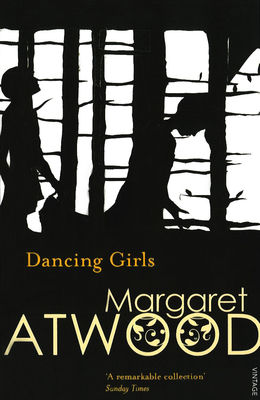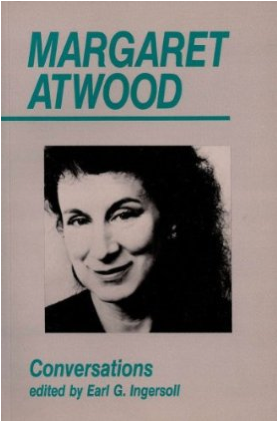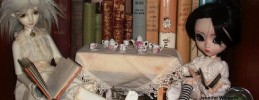
photo by Stefan van Bremen
by Wanda Campbell
Though ‘Rape Fantasies’ was written in 1975, it remains one of Atwood’s most widely known short stories largely because of its appearance in several editions of The Norton Anthology of Literature by Women and other popular anthologies. The story was sufficiently controversial as to be left out of the first American edition of Dancing Girls & Other Stories, perhaps because it might appear to a casual reader that Atwood was treating a serious issue in a cavalier, comic or naïve fashion, but a closer look at the story reveals that the narrator is so convinced of the seriousness of her subject that she must develop strategies that allow her not to be overwhelmed by it. ‘Rape Fantasies’ is set in Toronto, but at the time Atwood was writing Dancing Girls she was studying at Harvard. It was here, in Cambridge, Massachusetts, that she ‘first learned urban fear. (Before I went there, I always walked around at night, didn’t bother about locked doors etc. If you behaved that way in Cambridge you were dead)’. This is not exaggeration on Atwood’s part. In Crime Victim Stories: New York City’s Urban Folklore, Eleanor Wachs relates some shocking crime-victim statistics for the year in which Atwood’s story was published: ‘The Uniform Crime Report for 1977 reported that a murder took place every twenty-seven minutes in the United States. A forcible and violent rape occurred every eight seconds’.
 Atwood’s story involves a group of four female office workers chatting over a bridge game in the lunch room. Responding to an article in a magazine she is reading, one of the women invites the others to share their ‘rape fantasies’. Though leavened with considerable irony and satire, the stories told by Atwood’s women share several significant characteristics with crime-victim narratives which, according to Wachs, make an overwhelming situation more manageable by allowing the tellers and listeners to ‘humanize the problem, reduce a nebulous fear […] and attempt to gain some control over their lives and actions’. These tales are not so much about violence as they are about ‘survival and perseverance’ (Wachs), central themes of all Atwood’s work.
Atwood’s story involves a group of four female office workers chatting over a bridge game in the lunch room. Responding to an article in a magazine she is reading, one of the women invites the others to share their ‘rape fantasies’. Though leavened with considerable irony and satire, the stories told by Atwood’s women share several significant characteristics with crime-victim narratives which, according to Wachs, make an overwhelming situation more manageable by allowing the tellers and listeners to ‘humanize the problem, reduce a nebulous fear […] and attempt to gain some control over their lives and actions’. These tales are not so much about violence as they are about ‘survival and perseverance’ (Wachs), central themes of all Atwood’s work.
The first story told by Greta is of a man dressed all in black coming through the sliding balcony door of her apartment on the eighteenth floor, having made his way from balcony to balcony by use of a rope and a hook. Estelle, the narrator and debunker of Atwood’s story, realizes immediately that she has seen this same show on television.
Chrissy then proceeds to tell her tale of a handsome stranger finding her naked in a bubble bath and joining her. Estelle is quick to point out that these women’s stories are not about rape but about desire because there is no anxiety, coercion, or violence. ‘“Rape,” she says, “is when they’ve got a knife or something and you don’t want to.”’
Atwood’s narrator Estelle turns a critical eye toward the stories told by her co-workers, in an effort to suggest why the erotic nature of fantasy and the brutal reality of rape are really poles apart. She argues that those who conflate the two do so at their peril. After having made the distinction between actual rape and the ‘rape fantasies’ the woman have revealed, Estelle then offers several of her own scenarios. In each she is able to defend herself from a rapist in various ways, including squirting a plastic lemon in his eye, kung fu, sympathy for his acne, convoluted religious claims, or a shared fatal illness. Her tales, tinged with both humour and horror, and filtered through the inimitable imagination of Atwood, seem always too good to be true. Yet, they share the common thread of depriving the rapist of his power by somehow revealing his weakness. Estelle’s scenarios all manage to ultimately make the rapist pathetic and ineffectual, whether because his zipper gets stuck, or he has a terrible cold, or terrible acne, or a terrible disease. ‘In my rape fantasies,’ Estelle says, ‘I always end up feeling sorry for the guy, I mean there has to be something wrong with them’. In each case, Estelle is able to defuse the situation by providing some remedy for the rapist, making him a Neo-Citran or recommending her dermatologist, or comforting him in his mortality. It is important to note that here, as in many tales of rape survivors, ‘the victim’s agency emerges from her ability to mimic socially acceptable female behaviour: women learn how not to upset violent men’ (Wendy S. Hesford, Hauting Violations), but resistance, however limited or culturally scripted, can and does save lives.
Estelle eventually relates a more frightening tale about an assailant hiding in her cellar with an axe who has been told by angels to kill her, but again, Estelle is able to talk her way out of the situation, using various details from her Catholic upbringing to convince her assailant that she is going to give birth to the reincarnation of St. Anne, and showing her odd shaped vaccination as proof. The potential rapist is so confused by her onslaught of detail that she is able to extricate herself from danger and convince him not to harm her. However, as he disappears up the coal chute, she notes that his shoes are the ‘old-fashioned kind that lace up the ankles’. This chilling detail suggests that there have always been and always will be those who feel a twisted call to violence against those who are weaker than themselves. From the opening line of her story, Atwood reveals that just because rape is receiving more attention in the media, doesn’t mean that it is a new problem.

Estelle tries not to think about this one too much. ‘My mother always said you shouldn’t dwell on unpleasant things and I generally agree with that, I mean dwelling on them doesn’t make them go away. Though not dwelling on them doesn’t make them go away either, when you come to think of it’. In Estelle’s final and most ‘touching’ scenario, the young woman says to her rapist ‘“You’d be raping a corpse,”’ because she has leukemia and, as it turns out, so does he; it is, in fact, his bitterness about the shortness of his life that is causing him to go around raping people. Ultimately, the two fatally ill individuals move in together and spend their last months in each others arms.
Atwood’s story ends with Estelle focusing on the power of these worrisome stories to reveal human vulnerability and our need to help rather than harm each other. ‘At work they call me the office worry wart,’ she says, ‘but it isn’t so much like worrying, it’s more like figuring out what you should do in an emergency’. Perhaps this method of imagining what we might do in a given situation is a way of preparing for reality. Sprinkled through the fictions are numerous “facts” about rape, that it is often someone you know rather than the handsome stranger Greta and Chrissy imagine coming through their windows, that there is coercion, and confusion, anxiety and violence, and that it is often as much about power as it is about sexuality.
When an interviewer asked Atwood why she was so preoccupied with such emotions as fear and anxiety in her fiction, she replied:
I would love to just sort of drift around and look at water lilies. Unfortunately, I can’t afford to. Wouldn’t it be nice if we had a world in which all we had to do was contemplate nature? Meanwhile this is the world we live in. And it’s all very well for some fellow to go sauntering off into the woods by himself. A woman thinks twice before she does that. Either she thinks twice or she’s a nut.
(from Margaret Atwood: Conversations)
Elsewhere in Conversations, Atwood notes that many support structures have broken down in our society, leaving people feeling vulnerable.
Because you don’t really know where the danger is coming from, fear takes the form often of a generalized anxiety or paranoia. You don’t know who the enemy is. You don’t know what direction you’ll be attacked from. So everybody ends up constantly swivelling around, looking for the next threat. People are afraid of whatever’s out there. And rightly so.
And yet, Atwood believes in the power of the word to bring people together, as a way to combat isolation and the resulting fear and aggression. In the penultimate paragraph of the story, we find out that Estelle has been telling all this to an unnamed stranger in a restaurant in which she feels safe because the waiters all know her and look out for her.
I don’t know why I’m telling you all this, except I think it helps you get to know a person, especially at first, hearing some of the things they think about […] I think it would be better if you could get a conversation going. Like, how could a fellow do that to a person he’s just had a long conversation with, once you let them know you’re human, you have a life too, I don’t see how they could go ahead with it, right?
Atwood has argued that if the writing and reading of novels has ‘any redeeming social value, it’s probably that they force you to imagine what it’s like to be somebody else. Which increasingly is something we all need to know’.
 Of course, the fantasy part of Atwood’s tale may be that talking could actually protect a person. However, telling stories, even untrue stories, may lead to the telling of true stories. To tell is to talk, and for Atwood, conversation is one hope for healing of the many rifts that divide the human community. As Wendy S. Hesford points out, fantasy, particularly revenge fantasy, can play a healing role in the case of rape, functioning as a kind of ‘talking cure’. Whether Atwood’s story is interpreted as an exploration of the relations between men and women, between human beings and their dangerous environment, between silence and speech, or even between nations, it still posits hope for survival and connection. ‘Hope,’ argues Atwood, ‘comes from the fact that people create, that they find it worthwhile to create. Not just from the nature of what is created’.
Of course, the fantasy part of Atwood’s tale may be that talking could actually protect a person. However, telling stories, even untrue stories, may lead to the telling of true stories. To tell is to talk, and for Atwood, conversation is one hope for healing of the many rifts that divide the human community. As Wendy S. Hesford points out, fantasy, particularly revenge fantasy, can play a healing role in the case of rape, functioning as a kind of ‘talking cure’. Whether Atwood’s story is interpreted as an exploration of the relations between men and women, between human beings and their dangerous environment, between silence and speech, or even between nations, it still posits hope for survival and connection. ‘Hope,’ argues Atwood, ‘comes from the fact that people create, that they find it worthwhile to create. Not just from the nature of what is created’.
In Atwood’s story, we see the cultural context of a dangerous new urban reality, potentially harmful assumptions about the source and nature of the menace, an examination of the patterns we live by, insights into the power and hazards of tale-telling, and the potential for dialogue and change. This story, like all good stories, reveals what it means to be human, capable of great creativity and cruelty, at once weak and worthy.
~
 Wanda Campbell teaches Creative Writing and Women’s Literature at Acadia University, in Wolfville Nova Scotia, Canada. She has published an anthology of early Canadian women poets, texts for Penguin, four poetry collections (Daedalus Had a Daughter, Grace, Looking for Lucy, and Sky Fishing), in addition to numerous academic and creative journal publications and a forthcoming novel.
Wanda Campbell teaches Creative Writing and Women’s Literature at Acadia University, in Wolfville Nova Scotia, Canada. She has published an anthology of early Canadian women poets, texts for Penguin, four poetry collections (Daedalus Had a Daughter, Grace, Looking for Lucy, and Sky Fishing), in addition to numerous academic and creative journal publications and a forthcoming novel.

